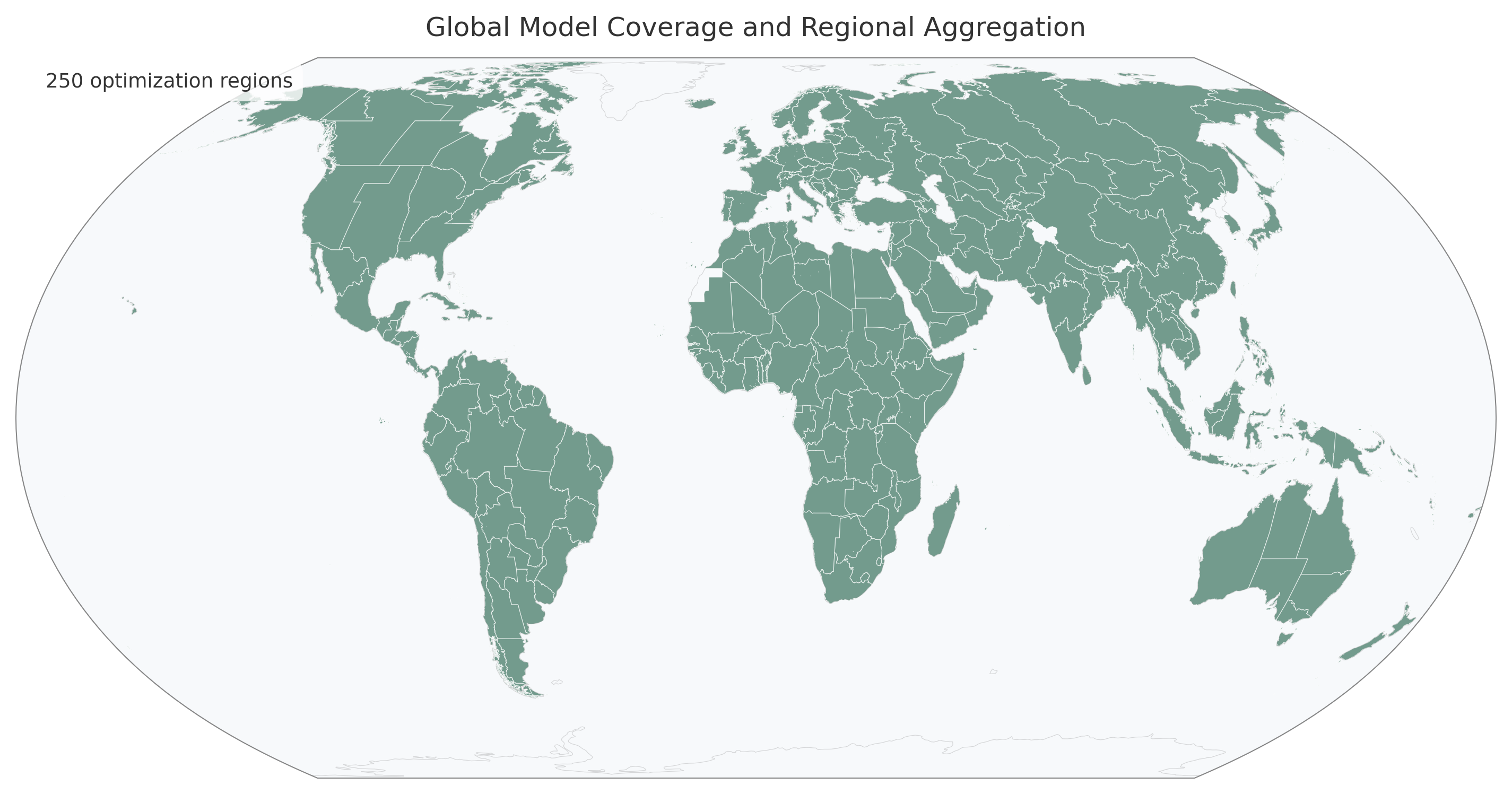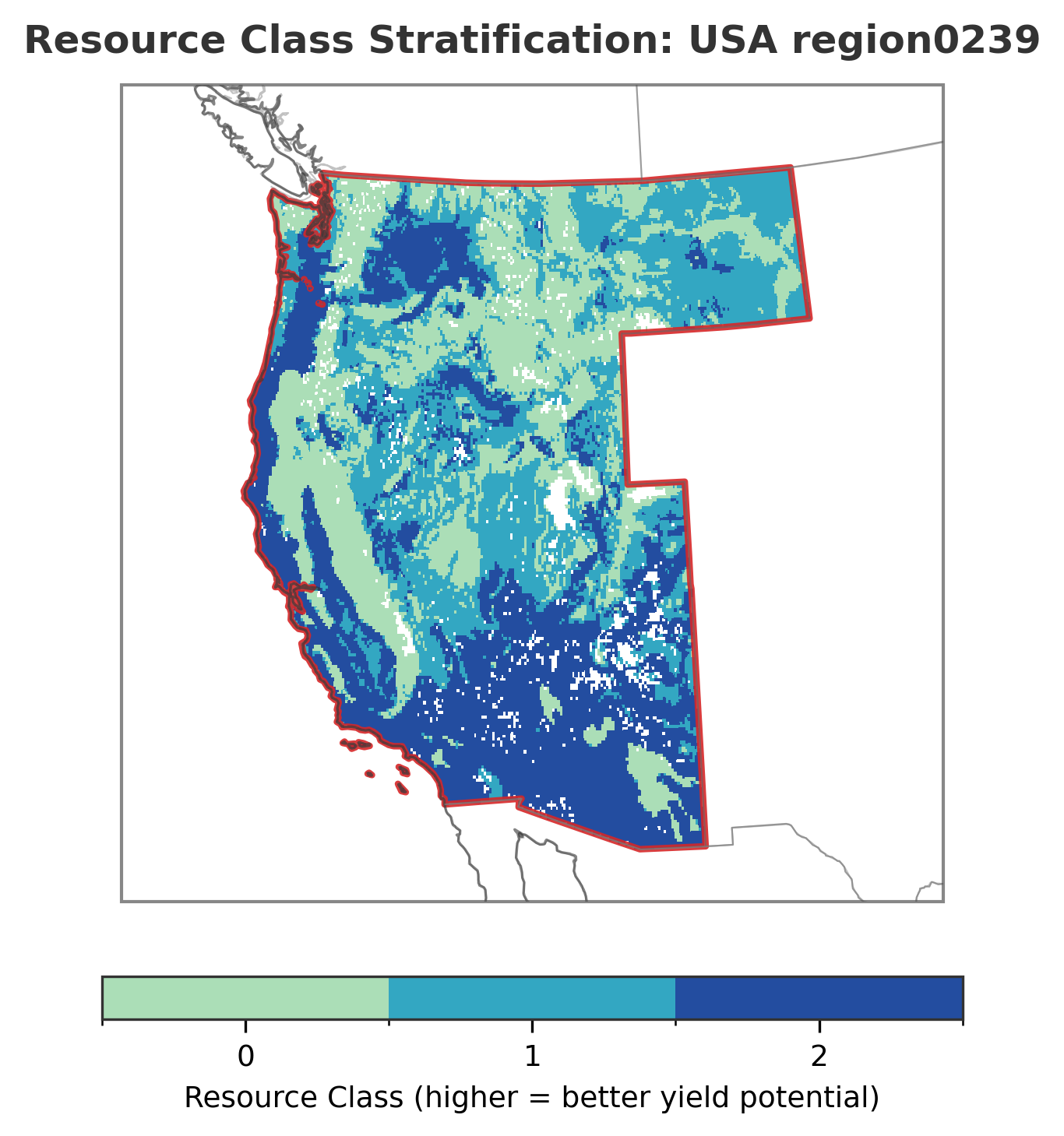Land Use & Resource Classes¶
Overview¶
The land use module translates high-resolution gridded yield potentials (0.05° × 0.05°, approximately 5.6 km at the equator) into aggregated land availability and yield parameters for the optimization model. This aggregation serves two purposes:
Computational efficiency: Reduces millions of gridcells to hundreds of optimization regions
Yield heterogeneity: Captures within-region variation in land quality using resource classes
Spatial Aggregation¶
Regional Clustering¶
The model operates at sub-national regional resolution, defined by clustering administrative units (GADM level 1) based on spatial proximity. The clustering process (workflow/scripts/build_regions.py) follows these steps:
Simplification: Simplify GADM geometries to reduce complexity while preserving boundaries
Controlled by
aggregation.simplify_tolerance_kmandaggregation.simplify_min_area_kmSmall enclaves are removed to avoid fragmentation
Country selection: Filter to configured countries (
countrieslist in config)Clustering: Aggregate administrative units into target number of regions
Method: k-means clustering on region centroids (default)
Target count:
aggregation.regions.target_count(e.g., 400)Cross-border clustering: Controlled by
aggregation.regions.allow_cross_border(typicallyfalse)
Output: GeoJSON with region polygons saved to
processing/{name}/regions.geojson
The result is a set of contiguous optimization regions that respect national boundaries (unless cross-border clustering is enabled) and balance spatial detail with computational tractability.

Global model coverage showing optimization regions created by clustering administrative units.¶
Resource Classes¶
Concept¶
Within each optimization region, agricultural land is heterogeneous—some areas have high yield potential, others low. To capture this heterogeneity without creating a separate decision variable for each gridcell, the model groups land into resource classes based on yield potential quantiles.
For example, with quantiles [0.25, 0.5, 0.75], each region has 4 resource classes:
Class 0: Bottom 25% of yield potential (lowest quality land)
Class 1: 25th-50th percentile
Class 2: 50th-75th percentile
Class 3: Top 25% of yield potential (highest quality land)
This allows the model to:
Preferentially allocate high-value crops to high-quality land
Avoid optimistic bias from averaging yields across heterogeneous land
Capture marginal land-use decisions
Computation¶
Resource classes are computed by workflow/scripts/compute_resource_classes.py:
Load yield rasters: Read GAEZ yield potentials for all crops (both rainfed and irrigated)
Running maximum: For each gridcell, compute the maximum attainable yield across all crops and water supplies
Converts kg/ha → t/ha (tonnes per hectare)
This represents the “best possible use” of each piece of land
Regional quantiles: Within each optimization region, compute yield quantiles
Uses
aggregation.resource_class_quantilesfrom config (e.g.,[0.25, 0.5, 0.75])Only considers gridcells with positive yield potential (deserts/ice don’t collapse bins)
Class assignment: Assign each gridcell to a resource class based on which quantile bin it falls into
Output: NetCDF file (
processing/{name}/resource_classes.nc) with:resource_class: Integer class ID for each gridcellmax_yield: Maximum yield potential across all cropsCoordinate reference system and geotransform for spatial reference
Visual Example¶
The figure below shows resource class stratification for a region in the western United States. Each colored pixel represents agricultural land classified by its yield potential, with darker blue indicating higher productivity (class 2) and lighter green-blue indicating lower productivity (class 0). The red boundary delineates the optimization region.

Resource class stratification within an example region. The spatial pattern reveals how land quality varies across the landscape, allowing the optimization model to preferentially allocate high-value crops to the most productive land while still utilizing lower-quality land for appropriate crops.¶
Numerical Example¶
For a region with yield distribution [0.1, 0.5, 1.2, 2.0, 3.5, 5.0, 8.0] t/ha stratified using quantiles [0.33, 0.67]:
Class 0: [0.1, 0.5, 1.2] t/ha (bottom third)
Class 1: [2.0, 3.5] t/ha (middle third)
Class 2: [5.0, 8.0] t/ha (top third)
Land Area Aggregation¶
Once resource classes are defined, the next step is to compute how much land is available in each region-class-water combination. This is handled by workflow/scripts/aggregate_class_areas.py.
Suitability-Based Limits¶
Land availability is constrained by suitability from GAEZ, which indicates what fraction of each gridcell is suitable for agriculture. GAEZ provides separate suitability rasters for rainfed and irrigated production (SX1 variable: share of cell assessed as “very suitable” or “suitable”).
The aggregation process:
Load resource classes: Read the class assignment raster from previous step
Load suitability: Read GAEZ suitability rasters for each crop and water supply
Compute suitable area: For each gridcell, multiply:
Cell area (in hectares, accounting for Earth’s curvature)
Suitability fraction (0-1)
Irrigated share (for irrigated crops) or
1 - irrigated_share(for rainfed)
Aggregate by region-class: Sum suitable area across all gridcells in each (region, resource_class, water_supply, crop) combination
Output: CSV file (
processing/{name}/land_area_by_class.csv) with columns:region: Optimization region IDresource_class: Class number (0, 1, 2, …)water_supply: “r” (rainfed) or “i” (irrigated)crop: Crop namearea_ha: Available area in hectares
Land Limit Dataset Options¶
The configuration parameter aggregation.land_limit_dataset controls how land availability is determined:
“suitability” (default): Use GAEZ suitability rasters per crop and water supply
More conservative: only counts land GAEZ deems suitable
Crop-specific: different crops have different suitable area
“irrigated”: Use irrigated cropland share for all crops
Simpler: all crops have the same suitable area per water supply
Based on GAEZ’s “land equipped for irrigation” dataset
The “irrigated” option is typically used when you want a uniform land base across all crops, while “suitability” is more realistic but creates more heterogeneity.
Irrigated vs. Rainfed Land¶
The model distinguishes between irrigated and rainfed production:
- Rainfed
Uses rainfall for water supply
Available on all suitable cropland not equipped for irrigation
Generally lower yields than irrigated
- Irrigated
Uses irrigation infrastructure
Only available on land equipped for irrigation (from GAEZ dataset)
Higher yields but requires blue water (see Crop Production for water constraints)
Controlled by
irrigation.irrigated_cropsconfig (can be “all” or a list)
For each optimization region and resource class, the model maintains separate land variables for rainfed and irrigated production. These compete for the same physical land, so the model includes constraints ensuring that total rainfed + irrigated land in a class doesn’t exceed available area.
Land Use Change¶
When the model allocates more land to agriculture than is currently used, this represents land use change (LUC). The environmental impacts of LUC (carbon emissions from clearing vegetation) are captured in the objective function.
The model does not currently distinguish between:
Expansion vs. intensification
Different LUC types (forest → cropland vs. grassland → cropland)
Historical vs. potential land
These are areas for future refinement. See Environmental Impacts for how LUC emissions are calculated.
Configuration Parameters¶
Key configuration parameters for land use aggregation (in config/default.yaml):
aggregation:
regions:
type: "cluster"
target_count: 400
allow_cross_border: false
method: "kmeans"
simplify_tolerance_km: 5
simplify_min_area_km: 25
resource_class_quantiles: [0.25, 0.5, 0.75]
# Crop land-use limitation source used when aggregating yields by region/resource class.
# - "suitability": limit area using GAEZ suitability rasters per water supply (irrigated/rainfed)
# - "irrigated": limit area using the irrigated cropland share (for irrigated) and its complement (for rainfed)
land_limit_dataset: "irrigated"
primary:
land:
regional_limit: 0.7 # fraction of each region's potential cropland that is made available.
fertilizer:
limit: 2e11 # kg (200 Mt total NPK - realistic global scale; converted to Mt inside the model)
# High-input agriculture N application rates (percentile of global FUBC data)
n_percentile: 80 # Use 80th percentile for high-input systems (range: 0-100)
synthetic_n2o_factor: 0.010 # kg N2O-N per kg N input (IPCC 2019 Refinement, Table 11.1 aggregated default)
The regional_limit parameter applies a global constraint on how much of each region’s suitable land can be used (0.7 = 70%). This represents institutional, ecological, or social constraints on agricultural expansion.
Workflow Rules¶
The land use aggregation workflow consists of three Snakemake rules:
simplify_gadm: Simplify administrative boundaries
Input:
data/downloads/gadm.gpkgOutput:
processing/shared/gadm-simplified.gpkgScript:
workflow/scripts/simplify_gadm.py
build_regions: Cluster into optimization regions
Input: Simplified GADM
Output:
processing/{name}/regions.geojsonScript:
workflow/scripts/build_regions.py
compute_resource_classes: Define resource classes
Input: Regions + all GAEZ yield rasters
Output:
processing/{name}/resource_classes.ncScript:
workflow/scripts/compute_resource_classes.py
aggregate_class_areas: Compute land availability
Input: Resource classes + suitability rasters + regions
Output:
processing/{name}/land_area_by_class.csvScript:
workflow/scripts/aggregate_class_areas.py
Visualization¶
Regional aggregation can be visualized using the regions map plotting rule:
tools/smk results/{name}/plots/regions_map.pdf
Resource class distribution can be visualized using:
tools/smk results/{name}/plots/resource_classes_map.pdf
These maps show the spatial distribution of optimization regions and the quality stratification of land within each region.